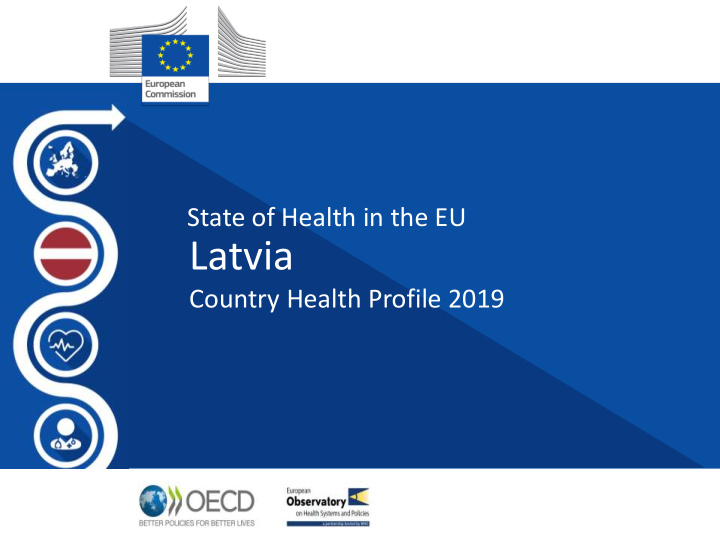



State of Health in the EU Latvia Country Health Profile 2019
Country Health Profile
Health of the Latvian population
Latvia reports the second lowest life expectancy in the EU
Deaths from CV diseases have decreased but mortality from cancer is on the rise Diseases of the circulatory system Accounted in 2016 for 56 % of all deaths, compared with slightly more than one-third across the EU.
The country still grapples with the control of infectious diseases The notification rate for HIV is the highest in the EU and unlike most other EU countries, the number of new HIV cases has been increasing since 2005
Many years of life after 65 are lived with some disabilities Half the population aged 65 and over report having at least one chronic condition, a proportion slightly below the EU average. Most people are able to live independently in old age, but more than one in six report some limitations in basic activities of daily Living.
Risk factors
Alcohol, tobacco and obesity are major public health issues - In 2014, one in four adults smoked daily – down from one in three in 2000, but still well above the EU average. - In the same year, one in five Latvians reported engaging in heavy alcohol consumption on a regular basis – a proportion close to the EU average. - The obesity rate was the second highest in the EU in 2017, with more than one in five Latvians being obese.
Health system in Latvia
Health expenditure is the second lowest in the EU Despite a 45 % increase since 2010, health expenditure per capita in Latvia remains the second lowest in the EU after Romania, at EUR 1 213 in 2017
A high proportion of health care resources are spent on pharmaceuticals - In 2017, about 31 % of Latvia’s health care budget was absorbed by the cost of medicines and medical devices – a proportion much higher than the EU average of 18 %. - However, in absolute terms, pharmaceutical spending in Latvia was one- third below the EU average (EUR 378 per person compared with EUR 522 in the EU).
Health workforce shortages are a major concern
Effectiveness of the health system
Many deaths could be avoided through better prevention and health care Nearly 6 000 deaths could have been avoided in 2017 through effective public health and prevention interventions, and a further 3 500 deaths through more appropriate and timely health care.
Some indicators of quality of care suggest that improvements are possible
Accessibility of the health system
A substantial share of the population report issues to access the care they need
Affordability is a major issue - OOP medical spending accounted for more than 4 % of final household consumption in Latvia in 2017, nearly twice as high as the EU average. - In 2013, almost 13 % of the Latvian population experienced catastrophic health spending, a major increase from the 2010 level of 10.6 % and the second highest proportion documented in the EU.
Resilience
The impacts of the economic crisis have been important More importantly, the twin challenges of increasing demand driven by an ageing population and population expectations of higher standards of care call for an improvement of the health system in terms of both efficiency and public investment.
Main messages
Main messages While the health of Latvians has improved since 2000, life expectancy remains six years below the EU average and the second lowest in Health Europe. Behavioral risk factors have a major impact on the health of the population. With a relatively small share of government spending allocated to health, the health system remains significantly underfunded. Despite Funding recent increases in spending, the share of GDP spent on health was 6.0 % in 2017, well below the EU average (9.8 %). Indicators of quality of care suggest that improvements are possible. A Quality greater emphasis on prevention could also lead to substantial health gains at a limited cost for the health system Health professionals are not in sufficient numbers and are not evenly Access distributed across the country. OOPs are the third highest in the EU and lead to high rates of catastrophic expenditure on health.
ec.europa.eu/health/state oecd.org/health/health-systems/country-health-profiles-EU.htm euro.who.int/en/about-us/partners/observatory/publications/country-health-profiles
Recommend
More recommend